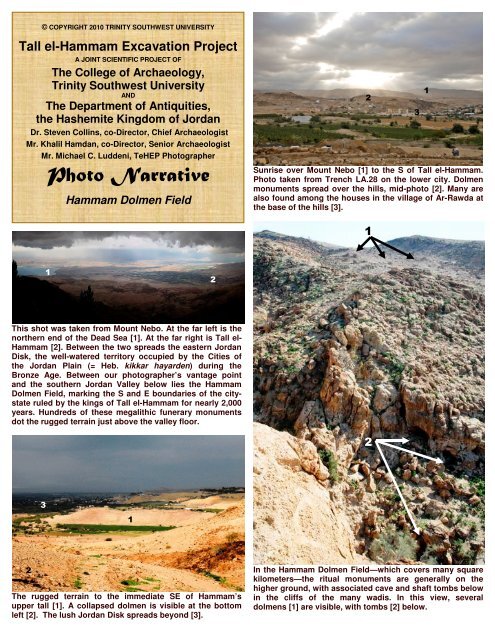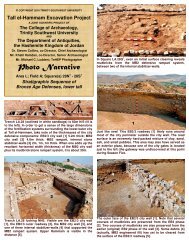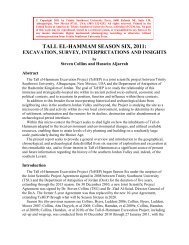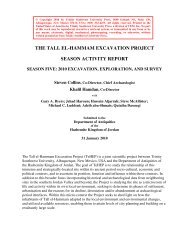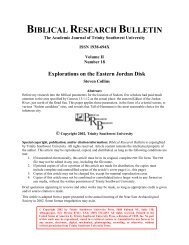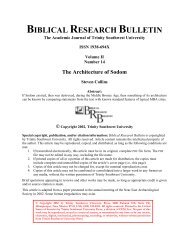Photo Narrative - Tall el-Hammam Excavation Project, Jordan
Photo Narrative - Tall el-Hammam Excavation Project, Jordan
Photo Narrative - Tall el-Hammam Excavation Project, Jordan
Create successful ePaper yourself
Turn your PDF publications into a flip-book with our unique Google optimized e-Paper software.
© COPYRIGHT 2010 TRINITY SOUTHWEST UNIVERSITY<br />
<strong>Tall</strong> <strong>el</strong>-<strong>Hammam</strong> <strong>Excavation</strong> <strong>Project</strong><br />
A JOINT SCIENTIFIC PROJECT OF<br />
The College of Archaeology,<br />
Trinity Southwest University<br />
AND<br />
The Department of Antiquities,<br />
the Hashemite Kingdom of <strong>Jordan</strong><br />
Dr. Steven Collins, co-Director, Chief Archaeologist<br />
Mr. Khalil Hamdan, co-Director, Senior Archaeologist<br />
This shot was taken from Mount Nebo. At the far left is the<br />
northern end of the Dead Sea [1]. At the far right is <strong>Tall</strong> <strong>el</strong>-<br />
<strong>Hammam</strong> [2]. Between the two spreads the eastern <strong>Jordan</strong><br />
Disk, the w<strong>el</strong>l-watered territory occupied by the Cities of<br />
the <strong>Jordan</strong> Plain (= Heb. kikkar hayarden) during the<br />
Bronze Age. Between our photographer’s vantage point<br />
and the southern <strong>Jordan</strong> Valley b<strong>el</strong>ow lies the <strong>Hammam</strong><br />
Dolmen Fi<strong>el</strong>d, marking the S and E boundaries of the citystate<br />
ruled by the kings of <strong>Tall</strong> <strong>el</strong>-<strong>Hammam</strong> for nearly 2,000<br />
years. Hundreds of these megalithic funerary monuments<br />
dot the rugged terrain just above the valley floor.<br />
2<br />
Mr. Micha<strong>el</strong> C. Luddeni, TeHEP <strong>Photo</strong>grapher<br />
<strong>Photo</strong> <strong>Narrative</strong><br />
3<br />
1<br />
<strong>Hammam</strong> Dolmen Fi<strong>el</strong>d<br />
The rugged terrain to the immediate SE of <strong>Hammam</strong>’s<br />
upper tall [1]. A collapsed dolmen is visible at the bottom<br />
left [2]. The lush <strong>Jordan</strong> Disk spreads beyond [3].<br />
1<br />
2<br />
2<br />
Sunrise over Mount Nebo [1] to the S of <strong>Tall</strong> <strong>el</strong>-<strong>Hammam</strong>.<br />
<strong>Photo</strong> taken from Trench LA.28 on the lower city. Dolmen<br />
monuments spread over the hills, mid-photo [2]. Many are<br />
also found among the houses in the village of Ar-Rawda at<br />
the base of the hills [3].<br />
1<br />
2<br />
In the <strong>Hammam</strong> Dolmen Fi<strong>el</strong>d—which covers many square<br />
kilometers—the ritual monuments are generally on the<br />
higher ground, with associated cave and shaft tombs b<strong>el</strong>ow<br />
in the cliffs of the many wadis. In this view, several<br />
dolmens [1] are visible, with tombs [2] b<strong>el</strong>ow.<br />
3<br />
1
1<br />
Large dolmen with <strong>Hammam</strong>’s upper tall [1] in the<br />
background. Topping megaliths can weigh several tons.<br />
Many of the <strong>Hammam</strong> dolmens were constructed during<br />
the Chalcolithic Period (4 th millennium BCE), according to<br />
ceramics found in the excavation of an intact dolmen<br />
chamber during Season Five (2010). Perhaps others were<br />
built during the Early Bronze Age. The ceramic data also<br />
reveals that dolmen rituals continued to be practiced for at<br />
least two millennia.<br />
1 2<br />
The <strong>Hammam</strong> Dolmen Fi<strong>el</strong>d also has many standing<br />
monoliths (menhirs) and stone circles. This menhir has<br />
several associated dolmens. <strong>Hammam</strong>’s lower tall [1] and<br />
upper tall [2] can be seen to the W.<br />
A partially-collapsed dolmen with <strong>Tall</strong> <strong>el</strong>-<strong>Hammam</strong> and the<br />
verdant Kikkar of the <strong>Jordan</strong> in the background.<br />
Dr. Steve McAllister makes notes on one of approximat<strong>el</strong>y<br />
500 dolmens documented by the TeHEP Team by GPS,<br />
photographs, and verbal descriptions, during Season Five.<br />
Lower <strong>Hammam</strong> [1] is visible in the background.<br />
Dr. Steve McAllister, Ken Schath, and Hussien Aljarrah<br />
pause for a photo-op during a long day of ‘dolmen hunting’.<br />
Another dolmen, looking westward over the Kikkar of the<br />
<strong>Jordan</strong>, the environs of <strong>Tall</strong> <strong>el</strong>-<strong>Hammam</strong>.<br />
1
A variation on the “A” dolmen type. Note the pile of dirt—<br />
foreground—cast up from the robbing of the dolmen<br />
chamber. Very few dolmens have survived the efforts of the<br />
‘night diggers’. As a result, undisturbed dolmen chambers<br />
are extrem<strong>el</strong>y rare. Because of the sheer numbers of<br />
dolmens in the <strong>Hammam</strong> Fi<strong>el</strong>d, a significant number of<br />
intact dolmens is lik<strong>el</strong>y. The excavation of these dolmens<br />
may shed a great deal of light on the mysteries<br />
surrounding the use of dolmens in remote antiquity.<br />
Stone circles often accompany dolmens. The r<strong>el</strong>ationship<br />
between the two is simply unknown, perhaps unknowable.<br />
Detailed data on each dolmen is important to interpretive<br />
theorizing. The <strong>Hammam</strong> Dolmen Fi<strong>el</strong>d extends to virtually<br />
every part of the landscape visible in this photograph.<br />
With the Kikkar of the <strong>Jordan</strong> in the far background, this<br />
dolmen is about 1 kilometer SW of <strong>Tall</strong> <strong>el</strong>-<strong>Hammam</strong>. With a<br />
Bronze Age city-state population perhaps exceeding 50,000<br />
people living within the approximat<strong>el</strong>y 100 square<br />
kilometers of its territory, death and its accompanying rites<br />
and rituals was certainly routine for local residents.<br />
Perhaps streams of mourners—or memorial c<strong>el</strong>ebrants—<br />
making their way up to a family/clan(?) dolmen was a<br />
common sight.<br />
Some dolmens seem to be free-standing. Others are found<br />
in groups, even in large circles of dolmens. TeHEP is<br />
studying these singular and cluster phenomena and their<br />
possible r<strong>el</strong>ationships to the socio-cultural significance of<br />
the dolmen landscape.<br />
One of hundreds of known tombs in close proximity to<br />
<strong>Hammam</strong> dolmens.
The ‘hills’ surrounding the <strong>Hammam</strong> city-state to the south<br />
and east comprise an austere, almost foreboding,<br />
environment. The sandstone formations are extrem<strong>el</strong>y<br />
rugged, and make for difficult hiking. This is the dolmen<br />
landscape of the <strong>Hammam</strong> Fi<strong>el</strong>d. In antiquity, these areas<br />
would have been places of isolation and solitude. Did the<br />
silence of this setting serve to magnify the steps and songs<br />
of ancient funerary processions? Was it some sort of<br />
ancestor worship, or seasonal memorial c<strong>el</strong>ebration that<br />
motivated the erection of the dolmen monuments?<br />
TeHEP Chief Archaeologist, Dr. Steven Collins, views both<br />
lower [1] and upper [2] <strong>Tall</strong> <strong>el</strong>-<strong>Hammam</strong> from the top of a<br />
hill to the SE. From this point, there are dolmens in all<br />
directions, including dozens in the areas of housing in the<br />
foreground. It’s estimated that over 500 dolmens have been<br />
destroyed by housing dev<strong>el</strong>opments and military activities.<br />
1<br />
1<br />
2<br />
On an earthen platform in the hills to the east, a collapsed<br />
dolmen overlooks <strong>Tall</strong> <strong>el</strong>-<strong>Hammam</strong> and the lush <strong>Jordan</strong><br />
Disk beyond. Both lower [1] and upper [2] talls are visible.<br />
2<br />
Upright megaliths are routin<strong>el</strong>y buried up to 1m in the<br />
ground. Most have underground chambers with stone-slab<br />
floors and blocking stones. Some chambers would have<br />
been entered from the top, others from the side.<br />
It’s amazing, in such an earthquake-prone region, that so<br />
many dolmen top-slabs are still in place—some<br />
precariously so.<br />
This is a classic ‘Type A’ dolmen built on a platform made<br />
of stones placed in a square or circular pattern.
A dolmen cluster. Is it possible that individual dolmens<br />
represent families? Do clusters represent clans? Such<br />
questions are difficult to answer. Perhaps the answers to<br />
these and other questions will be forthcoming as research<br />
on the <strong>Tall</strong> <strong>el</strong>-<strong>Hammam</strong> Dolmen Fi<strong>el</strong>d continues in the years<br />
to come.<br />
In the fi<strong>el</strong>d of dolmen research there are far more questions<br />
than answers. Whether or not any significance can be<br />
attached to it or not, one fact is certain: dolmens are as<br />
different from one another as snowflakes. Each seems to<br />
have its own mysterious personality—its own quirks and<br />
deviations that make it unique.<br />
Dolmens are silent sentin<strong>el</strong>s to the reality of death. Perhaps<br />
they can also reveal insights into their builders’ lives.<br />
Were the horizontal dolmen top-stones platforms upon<br />
which the bodies of deceased r<strong>el</strong>atives would be placed for<br />
a period of desiccation and disintegration as ‘back to<br />
nature’ offerings? The much-later Zoroastrians had similar<br />
funerary rites, which are still practiced today. Whole<br />
sk<strong>el</strong>etal remains are extrem<strong>el</strong>y rare in dolmen chambers<br />
and associated cave and shaft tombs, suggesting that<br />
some manner of pre-burial rites contributed to the loss of<br />
many bones, perhaps carried away by birds and/or animals.<br />
Thus, what were interred in dolmen chambers may have<br />
been ritually-representative ancestral bones, placed with an<br />
offering of scented oil or perfume in a small juglet, or<br />
perhaps a small bowl of grain or fruit. Again, there are more<br />
questions than answers.<br />
Another dolmen cluster near <strong>Tall</strong> <strong>el</strong>-<strong>Hammam</strong>. What<br />
worldview motivated the investment of time, energy, and<br />
financial resources to erect hundreds of these megalithic<br />
structures around <strong>Tall</strong> <strong>el</strong>-<strong>Hammam</strong> and its sat<strong>el</strong>lite towns<br />
and villages?<br />
© Copyright 2010 by Trinity Southwest University Press,<br />
5600 Eubank NE, Suite 130, Albuquerque, New Mexico<br />
87111, USA; (505) 332-4253. All rights reserved. Created in<br />
the United States of America by Trinity Southwest University<br />
Press, a division of CEM, Inc. No part of this work may be<br />
reproduced, stored in a retrieval system, or transmitted in<br />
any form or by any means, <strong>el</strong>ectronic, digital, mechanical,<br />
photocopying, recording, or otherwise, without written<br />
permission from Trinity Southwest University.


